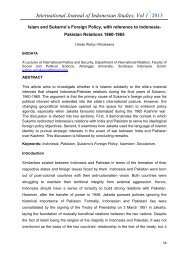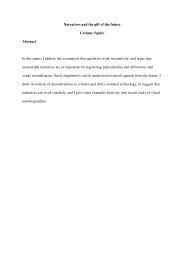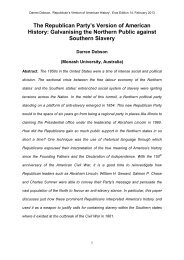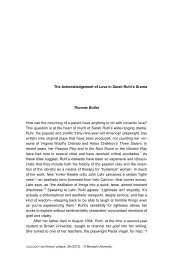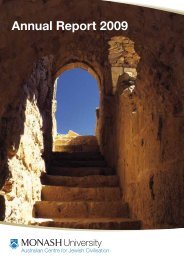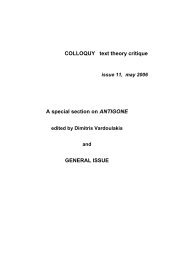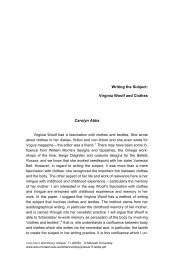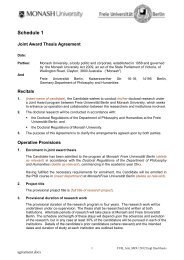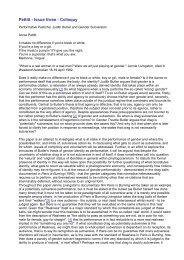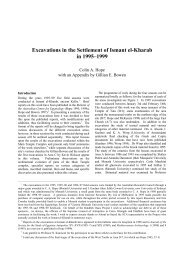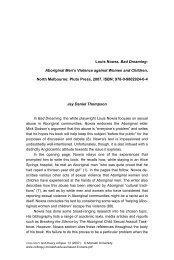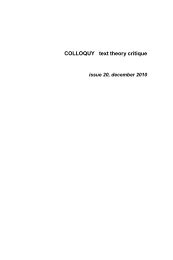Influence and Implications of Renaissance Humanism in Leonardo
Influence and Implications of Renaissance Humanism in Leonardo
Influence and Implications of Renaissance Humanism in Leonardo
Create successful ePaper yourself
Turn your PDF publications into a flip-book with our unique Google optimized e-Paper software.
░ <strong>Influence</strong> <strong>and</strong> <strong>Implications</strong> <strong>of</strong> <strong>Renaissance</strong> <strong>Humanism</strong> 137cial patronage for survival, his experience was different from that <strong>of</strong> artistswho had preceded him. Pr<strong>in</strong>cipally, as opposed to engag<strong>in</strong>g <strong>in</strong> vigorous competitionfor limited commissions, his skill ensured that he was able to carefullychoose his patrons; furthermore, his works were among the first to be collected,regardless <strong>of</strong> their content. 12 This was not, however, the case for most<strong>of</strong> his contemporaries; <strong>in</strong>deed, even as late as the sixteenth century, patronswere <strong>of</strong>ten considered the “makers” <strong>of</strong> the work, thus highlight<strong>in</strong>g the directconceptual association between f<strong>in</strong>ance <strong>and</strong> creativity, also evident <strong>in</strong> earlierassociations between patronage <strong>and</strong> a “nobility <strong>of</strong> heart.” 13Perhaps <strong>in</strong> response to this apparent threat, <strong>Leonardo</strong>'s <strong>in</strong>fluential work<strong>of</strong>fers a paradigmatic shift <strong>in</strong> power relations from patron to the artist. His treatisedemonstrates a language <strong>of</strong> process, <strong>in</strong>dicative <strong>of</strong> his emphasis upon theformal, mechanical element <strong>of</strong> the artistic activity, as opposed to its subjectmatter or potential reception. 14 <strong>Leonardo</strong> thus attempts to shift focus from the“false” productive role <strong>of</strong> the patron, to the “true” productivity <strong>of</strong> the artist; assuch, he transfers power from f<strong>in</strong>ance to mechanical praxis. 15 While the <strong>in</strong>dividualartist is the focus <strong>of</strong> <strong>Leonardo</strong>'s analysis, his true concern is the redef<strong>in</strong>ition<strong>of</strong> the artist as a composer <strong>of</strong> form.This crucial shift highlights a significant discrepancy between the idealrealm <strong>of</strong> <strong>Leonardo</strong>'s treatise, <strong>and</strong> social realities for the renaissance artist.Pr<strong>in</strong>cipally, this issue is manifest <strong>in</strong> the unresolved problem <strong>of</strong> the renaissancepatron as “maker” <strong>of</strong> the work, <strong>in</strong> spite <strong>of</strong> <strong>Leonardo</strong>'s alternative proposition<strong>and</strong> apparent resolution.<strong>Leonardo</strong>’s <strong>in</strong>sufficiency <strong>in</strong> justify<strong>in</strong>g the autonomy <strong>of</strong> the artist requirescloser exam<strong>in</strong>ation. As opposed to an explicit dismissal <strong>of</strong> the notion <strong>of</strong> “productivepatronage,” <strong>Leonardo</strong> encourages a “narrow<strong>in</strong>g <strong>of</strong> focus,” an <strong>in</strong>creasedspecificity which does not exclude, but <strong>in</strong>corporates as difference,such external <strong>in</strong>fluence as a condition<strong>in</strong>g aspect <strong>of</strong> the artistic process. 16 Significantly,the patron is relegated to the “shadows” <strong>of</strong> the artist's workshop.<strong>Leonardo</strong>'s <strong>in</strong>tention, <strong>and</strong> the necessity <strong>of</strong> this apparent exclusion, will bemade clear through an exam<strong>in</strong>ation <strong>of</strong> artistic techniques which <strong>Leonardo</strong> heldto be the most essential; <strong>in</strong> particular, One-Po<strong>in</strong>t Perspective <strong>and</strong> sfumato.The first artists credited with the pictorial emancipation from medievaltwo-dimensional pa<strong>in</strong>t<strong>in</strong>g were the thirteenth century pa<strong>in</strong>ters Giotto <strong>and</strong> Duccio.In particular, Giotto developed a method referred to as "depth by way <strong>of</strong>empathy"; the generation <strong>of</strong> the third-dimension <strong>of</strong> depth from a twodimensionalsurface through the manipulation <strong>of</strong> figures <strong>in</strong> space, rather thanthe manipulation <strong>of</strong> space itself. 17 The illusion <strong>of</strong> depth, loosely referred to as"two-po<strong>in</strong>t perspective,” was achieved by Giotto through the placement <strong>of</strong> objects“slantwise” <strong>in</strong> space, with the result that the previously solid plane appearedto “lose its materiality.” 18
138Chris Bassett░Build<strong>in</strong>g upon the foundation laid by the work <strong>of</strong> Giotto <strong>and</strong> Duccio, theFlorent<strong>in</strong>e architect <strong>and</strong> sculptor Filippo Brunelleschi designed a successfulperspectival method based upon architectural pr<strong>in</strong>ciples. This system, compris<strong>in</strong>g<strong>of</strong> a ground plan <strong>and</strong> a vertical structure, has been attributed toBrunelleschi approximately fifteen years prior to the most famous proponent <strong>of</strong>perspectival design, Leon Battista Alberti. 19Considered to have been <strong>in</strong>fluenced by Brunelleschi's design, Alberti wasthe first artist to document a detailed, mathematical approach to one-po<strong>in</strong>tperspective. 20 Brunelleschi's <strong>in</strong>fluence is apparent <strong>in</strong> the <strong>in</strong>corporation <strong>of</strong> thevertical aspect <strong>in</strong>to his pre-designed perspectival tool, a geometrical grid (velum),used by Alberti <strong>in</strong> a workshop. 21 As such, the mature form <strong>of</strong> one-po<strong>in</strong>tperspective featured the convergence <strong>of</strong> all parallel l<strong>in</strong>es <strong>in</strong>to “vanish<strong>in</strong>gpo<strong>in</strong>ts.” 22 All parallels <strong>in</strong>tersect<strong>in</strong>g at right angles (orthogonals) converged at acentral “vanish<strong>in</strong>g po<strong>in</strong>t,” thus produc<strong>in</strong>g a “horizon” effect. 23An architect by pr<strong>of</strong>ession, though also credited with pa<strong>in</strong>ted works <strong>of</strong>limited quality, Alberti's aim appears to have been to transfer the three dimensionalaspects <strong>of</strong> architecture <strong>and</strong> sculpture <strong>in</strong>to the realm <strong>of</strong> pa<strong>in</strong>t<strong>in</strong>g, as part<strong>of</strong> an anticipated historical development which would culm<strong>in</strong>ate <strong>in</strong> a dissolution<strong>of</strong> boundaries between humans <strong>and</strong> div<strong>in</strong>e nature. 24 Geometric perspective,he argued, would permit man to accurately re-produce nature, with theaim <strong>of</strong> eventual transcendence. 25Alberti's apparently hubristic aim <strong>of</strong> transcend<strong>in</strong>g nature through art emphasisesthe radical potential <strong>of</strong> one-po<strong>in</strong>t perspective. A mathematicallygroundedapproach, one-po<strong>in</strong>t perspective permits the artist to apparently “recreate”perspectival vision by scientific means, transcend<strong>in</strong>g merely symbolicpa<strong>in</strong>t<strong>in</strong>g. 26 As such, the artist equipped with this technique effectively threatenedto displace God as creator <strong>of</strong> “reality”; <strong>in</strong>deed, this implication is clear <strong>in</strong>Descartes' reference to the three-dimensionality <strong>of</strong> perspective as a substanceétendue (the implicitly cont<strong>in</strong>uous <strong>and</strong> <strong>in</strong>f<strong>in</strong>ite extension <strong>of</strong> the subject).27 That which secured the centrality <strong>of</strong> God, however, was the twodimensionalnature <strong>of</strong> the canvas, which provided an implicit limit to the creativity<strong>of</strong> humans <strong>in</strong> relation to the Div<strong>in</strong>e. Thus, one-po<strong>in</strong>t perspective rema<strong>in</strong>edthe illusion <strong>of</strong> perspectival vision; as such, it concretely re<strong>in</strong>forced theimpression <strong>of</strong> an ambiguity implicit with<strong>in</strong> the renaissance conception <strong>of</strong> humanitas.The ramifications <strong>of</strong> the development <strong>of</strong> perspective upon the perceivedstatus <strong>of</strong> the artist were evident <strong>in</strong> the contemporary transformation <strong>of</strong> artisticschool<strong>in</strong>g. Euclidean geometry, the foundation <strong>of</strong> Alberti's approach, requireda greater degree <strong>of</strong> mathematical skill than was usually taught at a basiclevel. 28 In pre-<strong>Renaissance</strong> Italy, all children attended the botteghuzza, anearly level school<strong>in</strong>g, after which the more promis<strong>in</strong>g children cont<strong>in</strong>ued to at-
░ <strong>Influence</strong> <strong>and</strong> <strong>Implications</strong> <strong>of</strong> <strong>Renaissance</strong> <strong>Humanism</strong> 139tend Abacus schools, <strong>in</strong> which they were taught basic mathematics <strong>and</strong> geometry,sufficient for merchant occupations. 29 Artist apprenticeships followed,known as bottega, <strong>in</strong> which students would practice <strong>in</strong> a room adjacent to theirmaster. 30The early <strong>Renaissance</strong> period witnessed a significant development <strong>in</strong> artistictutelage. One effect <strong>of</strong> recent changes was an <strong>in</strong>crease <strong>in</strong> artistic freedom,previously limited to the “liberal” arts <strong>of</strong> literature <strong>and</strong> poetry, a transformationevident with<strong>in</strong> the bottega. 31 Of greater significance, however, was thedevelopment <strong>of</strong> a higher level <strong>of</strong> artisanal study, the studium, <strong>in</strong> which highermathematics <strong>and</strong> geometry, as well as perspective <strong>and</strong> foreshadow<strong>in</strong>g, weretaught. 32Thus considered, the <strong>in</strong>ternal realm <strong>of</strong> artistic tutelage reflected the decentralisation<strong>of</strong> the religious realm <strong>in</strong> response to the rise <strong>of</strong> humanism.Whereas pre-renaissance tutelage had focused upon a direct, imitatory relation<strong>of</strong> the student to their master, the <strong>in</strong>creas<strong>in</strong>g centrality <strong>of</strong> the human asthe site <strong>of</strong> knowledge witnessed a movement towards an <strong>in</strong>creas<strong>in</strong>g artistic<strong>in</strong>dependence for students. Students were taught not simply to imitate, but toexperiment.III.With his Paragone, <strong>Leonardo</strong> stood at the <strong>in</strong>tersection <strong>of</strong> humanist values,<strong>and</strong> a correspond<strong>in</strong>g rise <strong>in</strong> an empirical, scientific attitude. The foundation<strong>of</strong> <strong>Leonardo</strong>'s position rest upon a belief <strong>in</strong> the positive role <strong>of</strong> human,sensible experience, the epistemic centrality <strong>of</strong> human, analytic thought, <strong>and</strong> arejection <strong>of</strong> the medieval notion <strong>of</strong> div<strong>in</strong>e <strong>in</strong>spiration <strong>in</strong> favor <strong>of</strong> human <strong>in</strong>tuition.Experience was central. <strong>Leonardo</strong> associated the work <strong>of</strong> the artist withthat <strong>of</strong> a scientist; as the scientist engaged <strong>in</strong> experiment, the artist ought tosimilarly engage with the natural world. 33 Experience was thus contrastaga<strong>in</strong>st imag<strong>in</strong>ation, which <strong>Leonardo</strong> held to be the weakest aspect <strong>of</strong> theprocess <strong>of</strong> pa<strong>in</strong>t<strong>in</strong>g. 34 This contrast between the sensible <strong>and</strong> the (<strong>in</strong>ferior)ephemeral, as between the known <strong>and</strong> unknown, is fundamental to <strong>Leonardo</strong>'streatise, plac<strong>in</strong>g it securely <strong>in</strong> accordance with the history <strong>of</strong> westernphilosophy s<strong>in</strong>ce Plato, <strong>and</strong> as such re-assert<strong>in</strong>g its humanist character. 35Coupled with experience, <strong>Leonardo</strong> emphasised the centrality <strong>of</strong> the <strong>in</strong>dividualthrough a glorification <strong>of</strong> the visual sense. 36 He described vision as "themost noble sense" recollect<strong>in</strong>g, <strong>and</strong> transcend<strong>in</strong>g, notions <strong>of</strong> a "noble heart";with<strong>in</strong> <strong>Leonardo</strong>'s work, morality gives way to scientific validity. 37 Of pr<strong>in</strong>cipal<strong>in</strong>terest for <strong>Leonardo</strong>, however, was the way <strong>in</strong> which he believed vision wasdirectly translatable <strong>in</strong>to perspectival pa<strong>in</strong>t<strong>in</strong>g. He understood visual perceptionas similar <strong>in</strong> function to that <strong>of</strong> a mirror, <strong>in</strong> which the “visual image” was re-
140Chris Bassett░flected onto a plane surface with<strong>in</strong> the eye (the “impressiva”), which was <strong>in</strong>turn apprehended with<strong>in</strong> the imag<strong>in</strong>ation. 38 As such, the m<strong>in</strong>d “possessed” theimage <strong>and</strong>, through the comb<strong>in</strong>ation <strong>of</strong> mechanical application <strong>and</strong> geometricperspective, translated directly <strong>in</strong>to pa<strong>in</strong>t<strong>in</strong>g. Consequently, the image <strong>of</strong> theeye, considered to be “universally <strong>in</strong>telligible,” was also scientifically verifiable.39 Crucially, the path <strong>of</strong> the image from div<strong>in</strong>e nature to canvas was consideredto be un<strong>in</strong>terrupted.Central to <strong>Leonardo</strong>'s conception <strong>of</strong> the nature <strong>of</strong> pa<strong>in</strong>t<strong>in</strong>g, <strong>and</strong> <strong>in</strong> turn hisunderst<strong>and</strong><strong>in</strong>g <strong>of</strong> the nature <strong>of</strong> reality, was the notion <strong>of</strong> "harmonic proportionality."40 The foundation <strong>of</strong> this conception was <strong>Leonardo</strong>'s underst<strong>and</strong><strong>in</strong>g thatthe universe was divided <strong>in</strong>to a multiplicity <strong>of</strong> m<strong>in</strong>ute fragments, travel<strong>in</strong>gthrough space at extraord<strong>in</strong>ary speeds. 41 The apparently solid vision <strong>of</strong> theworld which appears to perception is the result <strong>of</strong> the <strong>in</strong>tersection <strong>of</strong> thesefragments, which appear as "lum<strong>in</strong>ous rays,” form<strong>in</strong>g pyramidal shapes, which<strong>in</strong> turn <strong>in</strong>tersect, form<strong>in</strong>g a multiplicity <strong>of</strong> <strong>in</strong>f<strong>in</strong>itely smaller pyramids. 42With<strong>in</strong> <strong>Leonardo</strong>'s system, the artist “captures” the image <strong>of</strong> the world atthe moment at which the chaotic flux <strong>of</strong> fragments becomes untenable. Assuch, the artist ma<strong>in</strong>ta<strong>in</strong>s the momentary harmony <strong>of</strong> the elements, beforedispersal <strong>in</strong>to a myriad <strong>of</strong> other formations; the moment <strong>of</strong> time, considered asthe flux <strong>of</strong> the m<strong>in</strong>ute elements <strong>of</strong> the universe, is held still by the artist. 43With<strong>in</strong> <strong>Leonardo</strong>'s conception <strong>of</strong> the art <strong>of</strong> pa<strong>in</strong>t<strong>in</strong>g, the artist holds the image<strong>in</strong>tuitively, <strong>and</strong> presents it upon a two-dimensional surface, <strong>in</strong> the same wayas God views the world: "at a glance." 44However, perspective rema<strong>in</strong>ed ground <strong>in</strong> illusion; build<strong>in</strong>g upon the developments<strong>of</strong> Brunelleschi <strong>and</strong> Alberti, <strong>Leonardo</strong>'s Paragone outl<strong>in</strong>es a system<strong>of</strong> representation by which a two-dimensional surface may appear similarto a three-dimensional image. 45 Whereas Alberti emphasised the significance<strong>of</strong> colour, <strong>Leonardo</strong> <strong>in</strong>sists upon the chiaroscuro effect <strong>of</strong> shadow <strong>and</strong> light,comb<strong>in</strong>ed with perspective, otherwise known as sfumato. Hence, “life” is <strong>in</strong>s<strong>in</strong>uatedthrough perspective – the ma<strong>in</strong> l<strong>in</strong>es <strong>of</strong> bodies, the dim<strong>in</strong>ution <strong>of</strong> colourswith distance, <strong>and</strong> the loss <strong>of</strong> cognition <strong>of</strong> bodies with appropriate distance– <strong>and</strong> is further embodied through the addition <strong>of</strong> shadow <strong>and</strong> light. 46The apparent necessity <strong>of</strong> sfumato <strong>and</strong> perspective <strong>in</strong> themselves confirmthe limitation <strong>of</strong> the two-dimensional surface; although both engage withthe manipulation <strong>and</strong> enhancement <strong>of</strong> bodies <strong>in</strong> apparent space, their purposeis to create the illusion <strong>of</strong> space. <strong>Leonardo</strong>’s use <strong>of</strong> sfumato appears to confirmthat the third dimension rema<strong>in</strong>s beyond the artistic, creative reach <strong>of</strong> thepa<strong>in</strong>ter.Through the “realistic” presentation <strong>of</strong> the comb<strong>in</strong>ation <strong>of</strong> light <strong>and</strong> shade,<strong>Leonardo</strong>’s development <strong>of</strong> sfumato re<strong>in</strong>forces the dom<strong>in</strong>ant religious perspective,<strong>in</strong> which the <strong>in</strong>dividual is unable to st<strong>and</strong> with<strong>in</strong> the light <strong>of</strong> all knowl-
░ <strong>Influence</strong> <strong>and</strong> <strong>Implications</strong> <strong>of</strong> <strong>Renaissance</strong> <strong>Humanism</strong> 141edge. Yet <strong>Leonardo</strong> goes further, <strong>in</strong>sist<strong>in</strong>g that it is shadow which formallycreates the image. 47 Therefore, areas <strong>of</strong> shadow <strong>and</strong> darkness, spaces whichrema<strong>in</strong> concealed, appear to be <strong>in</strong>dicative <strong>of</strong> the limitation <strong>of</strong> human perspectivebefore the Div<strong>in</strong>e; <strong>and</strong>, by implication, it is the existence <strong>of</strong> this difference,manifest <strong>in</strong> darkness <strong>and</strong> light, which constitutes “reality.” 48This apparent limitation, despite its creative function, appears <strong>in</strong>congruouswhen considered <strong>in</strong> relation to <strong>Leonardo</strong>'s emphasis upon the epistemologicalcentrality <strong>of</strong> the human be<strong>in</strong>g; an argument which lends priority to empiricalperspective, scientific experiment <strong>and</strong> experience. It is necessary to reconsiderthis evaluation <strong>of</strong> sfumato.Throughout <strong>Leonardo</strong>'s major areas <strong>of</strong> focus with<strong>in</strong> the Paragone, thereexists one pr<strong>in</strong>ciple element <strong>in</strong> common: all relate to form or design. This isclear <strong>in</strong> terms <strong>of</strong> mechanical action <strong>and</strong> geometry; yet it is also evident <strong>in</strong> hisscientific consideration <strong>of</strong> optics, directly connected to mechanical applicationas opposed to the imag<strong>in</strong>ation. Similarly, <strong>in</strong> relation to sfumato, shadow is thatwhich “formally creates.” Sfumato is, therefore, a formal, design element, asmuch as optics or geometry. It is only secondarily “content.”Further, <strong>Leonardo</strong>'s conception <strong>of</strong> vision underm<strong>in</strong>es the significance <strong>of</strong>the imag<strong>in</strong>ation, <strong>in</strong> that it holds the viewed image, effectively stor<strong>in</strong>g it with<strong>in</strong>memory while the artist mechanically transfers it from impressiva to canvas.The process was direct, <strong>and</strong> scientifically repeatable. 49 <strong>Leonardo</strong> argued thatthe pa<strong>in</strong>ter possesses his object, the proportional harmony <strong>of</strong> the world.Whereas Alberti distanced man from the Div<strong>in</strong>e, yet anticipated a closure <strong>of</strong>the divide, <strong>Leonardo</strong> subtly shifts focus from method alone to a comb<strong>in</strong>ation <strong>of</strong>speculative biology <strong>and</strong> human, mechanical action; the artist does not <strong>in</strong>vent,but re-constitutes div<strong>in</strong>e nature. 50This suggestion is supported by the text <strong>of</strong> the Paragone, manifestthrough <strong>Leonardo</strong>'s specific avoidance <strong>of</strong> the terms creare <strong>and</strong> creazionewith<strong>in</strong> discussions <strong>of</strong> the relation between the human artist <strong>and</strong> the Div<strong>in</strong>e;rather, <strong>Leonardo</strong> uses as an alternative the more general terms, generare <strong>and</strong>generazione. The implication is clear; the role <strong>of</strong> the artist is not to create, butto formally re-establish div<strong>in</strong>e nature.Sfumato expresses that which is implicit throughout <strong>Leonardo</strong>'s treatise;<strong>in</strong> epistemological terms, it is present with<strong>in</strong> the dist<strong>in</strong>ction between a “knowable”<strong>and</strong> positively verifiable “reality,” <strong>and</strong> an “unknowable,” metaphysicalrealm. The extent <strong>of</strong> human <strong>in</strong>fluence is limited to formal elements, <strong>in</strong> contrastto essential or spiritual realms. In social terms, the dist<strong>in</strong>ction is apparent betweenthe formal mastery <strong>of</strong> technique by the artist, <strong>and</strong> the hidden, condition<strong>in</strong>grole <strong>of</strong> the patron.The Paragone – ostensibly an <strong>in</strong>structive work for artists - thereby revealsthe grow<strong>in</strong>g <strong>in</strong>fluence <strong>of</strong> empricism, as well as a systematicity ground
142Chris Bassett░by its own <strong>in</strong>ternal laws. Those elements which the system alienates –through their existence as oppositions which def<strong>in</strong>e the subject – simultaneouslydef<strong>in</strong>e the text as appropriate to a renaissance underst<strong>and</strong><strong>in</strong>g <strong>of</strong> humanism.Pan<strong>of</strong>sky writes: "The Humanist rejects authority. But he respects tradition."51 The <strong>in</strong>consistency <strong>of</strong> this statement perhaps best describes <strong>Leonardo</strong>'s“conditional emancipation” <strong>of</strong> the <strong>Renaissance</strong> artist. The rejection <strong>of</strong>authority necessitates a rejection also <strong>of</strong> dom<strong>in</strong>ant tradition; <strong>in</strong> much the sameway, a liberation <strong>of</strong> the artist would require a renunciation <strong>of</strong> traditional roles<strong>and</strong> context. <strong>Leonardo</strong>'s treatise <strong>of</strong>fers a theoretical freedom, pr<strong>in</strong>cipally acelebration <strong>of</strong> technical advances, as opposed to a reconfiguration <strong>of</strong> artisanalroles. Demonstrative <strong>of</strong> the repressive ambiguity with<strong>in</strong> the renaissance conception<strong>of</strong> <strong>Humanism</strong>, <strong>Leonardo</strong>'s text complies with a view <strong>of</strong> the human be<strong>in</strong>gslocated at a po<strong>in</strong>t “<strong>in</strong>-between” the creatively oppositional poles <strong>of</strong> darkness<strong>and</strong> light.Warwick Universitychris.bassett@hotmail.comNOTES1 Michael Bax<strong>and</strong>all, Giotto <strong>and</strong> the Orators: Humanist Observers <strong>of</strong> Pa<strong>in</strong>t<strong>in</strong>g <strong>in</strong> Italy<strong>and</strong> the Discovery <strong>of</strong> Pictorial Composition 1350-1450 (Oxford: Oxford UP, 1986),p. 1.2 Erw<strong>in</strong> Pan<strong>of</strong>sky, Mean<strong>in</strong>g <strong>in</strong> the Visual Arts (Chicago: Chicago UP, 1982), pp. 2-3.3 Pan<strong>of</strong>sky, Mean<strong>in</strong>g <strong>in</strong> the Visual Arts, p. 3.4 Pan<strong>of</strong>sky, Mean<strong>in</strong>g <strong>in</strong> the Visual Arts, p. 1.5 Brian Kempers, Pa<strong>in</strong>t<strong>in</strong>g, Power <strong>and</strong> Patronage: The Rise <strong>of</strong> the Pr<strong>of</strong>essional Artist<strong>in</strong> the Italian <strong>Renaissance</strong>, trans. Beverley Jackson (London: Allen Lane – ThePengu<strong>in</strong> Press, 1992), p. 22.6 Kempers, Pa<strong>in</strong>t<strong>in</strong>g, Power <strong>and</strong> Patronage, p. 22.7 John Stephens, The Italian <strong>Renaissance</strong>: The Orig<strong>in</strong>s <strong>of</strong> Intellectual <strong>and</strong> ArtisticChange before the Reformation (London & New York: Longman, 1990), p. 6.8 Stephens, The Italian <strong>Renaissance</strong>, p. 59.9 Stephens, The Italian <strong>Renaissance</strong>, p. 59.10 Stephens, The Italian <strong>Renaissance</strong>, p. 80.11 Kempers, Pa<strong>in</strong>t<strong>in</strong>g, Power <strong>and</strong> Patronage, p. 36.12 Andre Chastel, "Introduction,” The Genius <strong>of</strong> <strong>Leonardo</strong> da V<strong>in</strong>ci: <strong>Leonardo</strong> daV<strong>in</strong>ci on Art <strong>and</strong> the Artist, trans. Ellen Callmann (New York: The Orion Press,
░ <strong>Influence</strong> <strong>and</strong> <strong>Implications</strong> <strong>of</strong> <strong>Renaissance</strong> <strong>Humanism</strong> 1431961), p. xi.13 Claire Farago, <strong>Leonardo</strong> da V<strong>in</strong>ci's Paragone: A Critical Interpretation with a NewEdition <strong>of</strong> the Text <strong>in</strong> the Codex Urb<strong>in</strong>as (Leiden, New York, Københarn & Köln: E.J. Brill, 1992), p. 119.14 Farago, <strong>Leonardo</strong> da V<strong>in</strong>ci's Paragone, p. 334.15 Terms <strong>in</strong>dicative <strong>of</strong> value, <strong>in</strong> this case “true” <strong>and</strong> “false,” are appropriate with<strong>in</strong> thiscontext given the systemic structure <strong>of</strong> <strong>Leonardo</strong>'s Paragone. <strong>Leonardo</strong>'s systemwill be further elaborated <strong>and</strong> <strong>in</strong>vestigated with<strong>in</strong> this paper.16 “Process” here<strong>in</strong> refers to a mechanical, socially-ground movement.17 Erw<strong>in</strong> Pan<strong>of</strong>sky, <strong>Renaissance</strong> <strong>and</strong> Renascences <strong>in</strong> Western Art (Stockholm: Almqvist& Wiksell, 1960), p. 119.18 Pan<strong>of</strong>sky, <strong>Renaissance</strong> <strong>and</strong> Renascences <strong>in</strong> Western Art, p. 119.19 Pan<strong>of</strong>sky, <strong>Renaissance</strong> <strong>and</strong> Renascences <strong>in</strong> Western Art, p. 123, f. 2.20 The fact that Alberti was the first to document <strong>and</strong> publish these f<strong>in</strong>d<strong>in</strong>gs does not,however, rescue him from criticism. Vasari, <strong>in</strong> particular, cites Alberti as an example<strong>of</strong> the necessity for experience as well as theoretical knowledge relat<strong>in</strong>g to theproduction <strong>of</strong> artworks; while he duly notes that Alberti published widely, he impliesthat the published text implies a mastery not entirely applicable to the author– "such has been the <strong>in</strong>fluence <strong>of</strong> his writ<strong>in</strong>gs on the pens <strong>and</strong> speech <strong>of</strong> scholarlymen that he is commonly believed to be superior to those who were, <strong>in</strong> fact, superiorto him" (Giorgio Vasari, Artists <strong>of</strong> the <strong>Renaissance</strong>, trans. George Bull [London:Alien Lane, 1978], p. 129; cf. also, Pan<strong>of</strong>sky, <strong>Renaissance</strong> <strong>and</strong> Renascences<strong>in</strong> Western Art, p. 126, f. 2; <strong>and</strong>, Cecil Grayson, "Introduction,” On Pa<strong>in</strong>t<strong>in</strong>g <strong>and</strong> OnSculpture: The Lat<strong>in</strong> Texts <strong>of</strong> De Pictura <strong>and</strong> De Statua [London: Phaidon, 1972],p. 12).21 Pan<strong>of</strong>sky, <strong>Renaissance</strong> <strong>and</strong> Renascences <strong>in</strong> Western Art, p. 126.22 The use <strong>of</strong> the term “Vanish<strong>in</strong>g Po<strong>in</strong>t,” <strong>in</strong> this context, has been first attributed toVillard de Honnecourt; cf. Pan<strong>of</strong>sky, <strong>Renaissance</strong> <strong>and</strong> Renascences <strong>in</strong> WesternArt, p. 133.23 Erw<strong>in</strong> Pan<strong>of</strong>sky, Early Netherl<strong>and</strong>ish Pa<strong>in</strong>t<strong>in</strong>g: Its Orig<strong>in</strong>s <strong>and</strong> Character (Cambridge,MA: Harvard UP, 1953), p. 5.24 Vasari suggests that "<strong>in</strong> pa<strong>in</strong>t<strong>in</strong>g Alberti achieved noth<strong>in</strong>g <strong>of</strong> any great importanceor beauty" (Vasari, Artists <strong>of</strong> the <strong>Renaissance</strong>, p. 133; see also Grayson, "Introduction,”p. 18).25 Grayson, "Introduction,” pp. 10,15.26 Ground <strong>in</strong> Euclidean geometry, Alberti's treatise was unique <strong>in</strong> its focus upon acontemporary underst<strong>and</strong><strong>in</strong>g <strong>of</strong> Optics. Cf. Grayson, "Introduction,” p. 12.27 Pan<strong>of</strong>sky, Early Netherl<strong>and</strong>ish Pa<strong>in</strong>t<strong>in</strong>g, p. 5.28 Grayson, "Introduction,” p. 12.29 Frances-Anne Ames-Lewis, The Intellectual Life <strong>of</strong> the Early <strong>Renaissance</strong> Artist(New Haven & London: Yale UP, 2000), pp. 30-1.30 Ames-Lewis, The Intellectual Life <strong>of</strong> the Early <strong>Renaissance</strong> Artist, p. 35.
144Chris Bassett░31 Ames-Lewis, The Intellectual Life <strong>of</strong> the Early <strong>Renaissance</strong> Artist, p. 273.32 Ames-Lewis, The Intellectual Life <strong>of</strong> the Early <strong>Renaissance</strong> Artist, p. 57.33 <strong>Leonardo</strong> da V<strong>in</strong>ci, "Parte Prima,” <strong>Leonardo</strong> da V<strong>in</strong>ci's Paragone: A Critical Interpretationwith a New Edition <strong>of</strong> the Text <strong>in</strong> the Codex Urb<strong>in</strong>as. ed. Claire Farago(Leiden, NY, Københarn & Köln: E. J. Brill, 1992), Ch. 14, p. 197.34 Da V<strong>in</strong>ci, "Parte Prima,” Ch. 31, p. 251.35 It would seem clear that <strong>Leonardo</strong> would not have approved <strong>of</strong> the more keenlyradical work <strong>of</strong> Jan van Eyck, whose extension <strong>of</strong> the laws <strong>of</strong> perspective beyondsimple representation, <strong>and</strong> towards radical omniscience, appear to gesture towardslater Idealist philosophy. Van Eyck's approach, ground by the "two <strong>in</strong>f<strong>in</strong>ites"<strong>of</strong> the <strong>in</strong>f<strong>in</strong>itesimally small, <strong>and</strong> the <strong>in</strong>f<strong>in</strong>itely large, simultaneously presented with<strong>in</strong>the s<strong>in</strong>gle work, was achieved through a compositional technique which comprised<strong>of</strong> a seem<strong>in</strong>gly <strong>in</strong>f<strong>in</strong>ite multiplicity <strong>of</strong> details (cf. Pan<strong>of</strong>sky, Early Netherl<strong>and</strong>ishPa<strong>in</strong>t<strong>in</strong>g, p. 181). In this way, Van Eyck presented the vision <strong>of</strong> the artist asthat which appeared to genu<strong>in</strong>ely rival the perspective <strong>of</strong> the Div<strong>in</strong>e.36 Da V<strong>in</strong>ci, "Parte Prima,” Ch. 7, p. 192.37 Notably, the conception <strong>of</strong> vision as the "most noble" sense is characteristic <strong>of</strong>August<strong>in</strong>ian attitudes towards vision (Farago, <strong>Leonardo</strong> da V<strong>in</strong>ci's Paragone, p.292).38 Farago, <strong>Leonardo</strong> da V<strong>in</strong>ci's Paragone, p. 301.39 Da V<strong>in</strong>ci, "Parte Prima,” Ch. 7, p. 187.40 Da V<strong>in</strong>ci, "Parte Prima,” Ch. 15, p. 201 <strong>and</strong> Ch. 32, p. 249.41 Chastel, "Introduction,” p. xvi. See also John White, The Birth <strong>and</strong> Rebirth <strong>of</strong> PictorialSpace (London <strong>and</strong> Boston: Faber & Faber, 1987), p. 213.42 Chastel argues that Alberti held similar views, although there is no support<strong>in</strong>g evidencefor this with<strong>in</strong> On Pa<strong>in</strong>t<strong>in</strong>g (Chastel, "Introduction,” p. xvi).43 Chastel, "Introduction,” p. xvi.44 Da V<strong>in</strong>ci, "Parte Prima,” Ch. 14, pp. 197-9.45 Da V<strong>in</strong>ci, "Parte Prima,” Ch. 3, p. 181.46 Da V<strong>in</strong>ci, "Parte Prima,” Ch. 6, p. 185.47 Da V<strong>in</strong>ci, "Parte Prima,” Ch. 5, p. 181.48 Giovanni Maior<strong>in</strong>o, <strong>Leonardo</strong> da V<strong>in</strong>ci: The Daedalian Mythmaker (Pennsylvania:Pennsylvania State UP, 1992), p. 144.49 Subject, however, to the <strong>in</strong>stabilities <strong>of</strong> memory.50 Da V<strong>in</strong>ci, "Parte Prima,” Ch. 14, p. 197.51 Pan<strong>of</strong>sky, Mean<strong>in</strong>g <strong>in</strong> the Visual Arts, p. 3.



